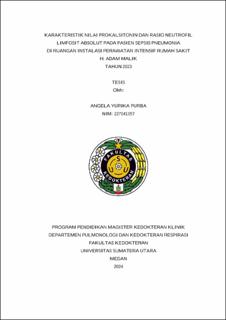Karakteristik Nilai Prokalsitonin dan Rasio Neutrofil Limfosit Absolut pada Pasien Sepsis Pneumonia di Ruangan Instalasi Perawatan Intensif Rumah Sakit H. Adam Malik Tahun 2023
Characteristics of Neutrophil to Lymphocite Ratio and Procalcitonin Level in Septic Pneumonia Patient at Intensive Care Unit Haji Adam Malik Hospital Medan 2023

Date
2024Author
Purba, Angela Yurika
Advisor(s)
Bihar, Syamsul
Sinaga, Bintang Yinke Magdalena
Metadata
Show full item recordAbstract
Background: According to the World Health Organization's global health estimates, lower respiratory infections are the fourth leading global cause of deaths and the deadliest communicable disease, causative for three million deaths worldwide in 2016. Despite the introduction of antibiotic therapies in the 1950s, pneumonia mortality has not decreased substantially, and sepsis, septic shock or acute pulmonary failure (eg acute respiratory distress syndrome, ARDS) are frequent secondary complications. To improve management and treatment of pneumonia, supporting microbiological and virological tests from throat swabs, sputum or blood cultures might be indicated to identify the responsible pathogen(s) and to allow targeted antimicrobial or antiviral therapy. This can be supported by blood biomarkers such as procalcitonin (PCT) and white blood cell count which are commonly used to differentiate between patients with pneumonia and individuals with pneumonia at risk for sepsis.
Objective: To determine the relationship between procalcitonin level and neutrophil to lymphocyte ratio in sepsis pneumonia patients.
Methods: This study was conducted with an observational analytic design conducted in a cross-sectional manner, from January 2023 to December 2023. The subjects of this study were taken from the population of sepsis pneumonia patients who were hospitalized at intensive care unit, were found to be 132 samples. Data included procalcitonin level and neutrophil to lymphocyte ratio from laboratory findings, were analyzed with univariate and bivariate method to assess the relationship between procalcitonin level and neutrophil to lymphocyte ratio.
Results: In this study, the highest age of sepsis pneumonia sufferers was found to be ≥60 years as many as 53 people (40.15%) with the highest gender being male as many as 81 people (61.37%). The highest lymphocyte levels were those with decreased values, namely 125 patients (94.70%), with the lowest neutrophil levels decreasing, namely 2 patients (1.52%). The patients with the highest NLR ratio were in the critical inflammation category, 66 patients (50%) and the highest procalcitonin value in sepsis patients was in the sepsis/other infection category, 52 patients (39.39%).
Conclusion: There is a prominent male predominance among sepsis patients. Sepsis disproportionately affects the elderly, with the majority of septic patients aged over 65 years. Studies show that nearly 60% of sepsis cases occur in this age group, highlighting the vulnerability of older adults to this severe infection. The neutrophil-to-lymphocyte ratio (NLR) has been identified as a useful prognostic marker in sepsis, with higher NLR levels correlating with increased mortality and disease severity. Elevated PCT levels are strongly associated with sepsis, with various studies highlighting its diagnostic accuracy.
